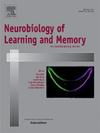长期轻度高脂饲粮促进家兔辨别学习,改变甘油磷脂代谢
IF 1.8
4区 心理学
Q3 BEHAVIORAL SCIENCES
引用次数: 0
摘要
先前的报告显示西方高脂肪饮食(HFD)和认知能力差之间存在关联。到目前为止,还没有关于轻度HFD是否会影响兔的学习和海马代谢谱的报道。本研究旨在探讨喂食轻度HFD(5%猪油和5%豆油)20周是否会影响眨眼识别和识别逆转学习以及海马代谢特征。饲喂高脂饲料或正常对照饲料20周后,所有家兔进行1天的适应,每天20次双音辨别(1 khz CS + +吹气和8 khz CS-不吹气),休息1天,然后每天40次辨别逆转(8 khz CS +和1 khz CS-)。与正常饲料相比,轻度HFD饲料对CS+的反应更高,对CS-的反应更低,对CS+−CS-的辨别指数更大。广泛靶向的代谢组学分析在海马中发现了1805种代谢物,在男性和女性中分别发现了hfd诱导的162种和165种差异代谢物的显著变化。这些物质包括甘油磷脂和脂肪酰基。KEGG富集分析显示,HFD组甘油磷脂代谢(ko00564)显著富集,尤其是溶血磷脂酰乙醇胺和溶血磷脂酰胆碱。总之,我们的数据表明,长期轻度HFD促进了兔子的辨别学习,而不会引起代谢综合征,并改变了海马代谢谱,这可能会影响神经元细胞膜脂质和行为表现。本文章由计算机程序翻译,如有差异,请以英文原文为准。

A long-term mild high-fat diet facilitates rabbit discrimination learning and alters glycerophospholipid metabolism
Previous reports have shown an association between a Western high-fat diet (HFD) and poor cognitive performance. So far, there are no reports of whether a mild HFD can affect rabbit learning and hippocampal metabolic profile. This study was designed to explore whether feeding a mild HFD (5 % lard and 5 % soy oil) for 20 weeks affected eyeblink discrimination and discrimination reversal learning and hippocampal metabolic profiles. After 20 weeks on the HFD or a normal control diet, all rabbits received one day of adaptation, 20 daily sessions of two-tone discrimination (1-kHz CS + followed by air puff and 8-kHz CS- not followed by air puff), a rest day, and then 40 daily sessions of discrimination reversal (8-kHz CS + and 1-kHz CS-). Compared to rabbits fed a regular chow diet, rabbits fed a mild HFD showed better discrimination evidenced by higher responding to CS+, lower responding to CS-, and a larger discrimination index (CS+ − CS-). Widely targeted metabolomics analysis identified 1805 metabolites in the hippocampus, and significant HFD-induced changes in 162 and 165 differential metabolites in males and females, respectively. These included glycerophospholipids and fatty acyls. KEGG enrichment analysis showed glycerophospholipid metabolism (ko00564) was significantly enriched in the HFD group notably lysophosphatidylethanolamine and lysophosphatidylcholine. In summary, our data show a long-term mild HFD facilitated discrimination learning in rabbits without inducing a metabolic syndrome, and altered the hippocampal metabolic profile, which may affect neuronal cell membrane lipids and behavioral performance.
求助全文
通过发布文献求助,成功后即可免费获取论文全文。
去求助
来源期刊
CiteScore
5.10
自引率
7.40%
发文量
77
审稿时长
12.6 weeks
期刊介绍:
Neurobiology of Learning and Memory publishes articles examining the neurobiological mechanisms underlying learning and memory at all levels of analysis ranging from molecular biology to synaptic and neural plasticity and behavior. We are especially interested in manuscripts that examine the neural circuits and molecular mechanisms underlying learning, memory and plasticity in both experimental animals and human subjects.

 求助内容:
求助内容: 应助结果提醒方式:
应助结果提醒方式:


